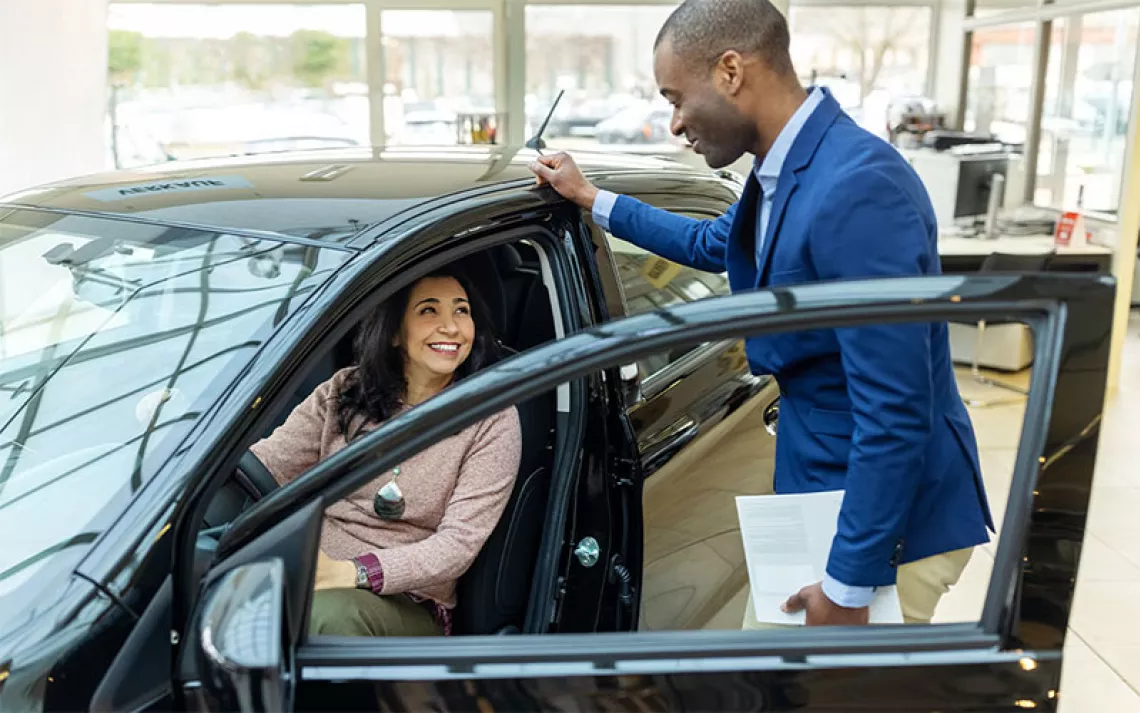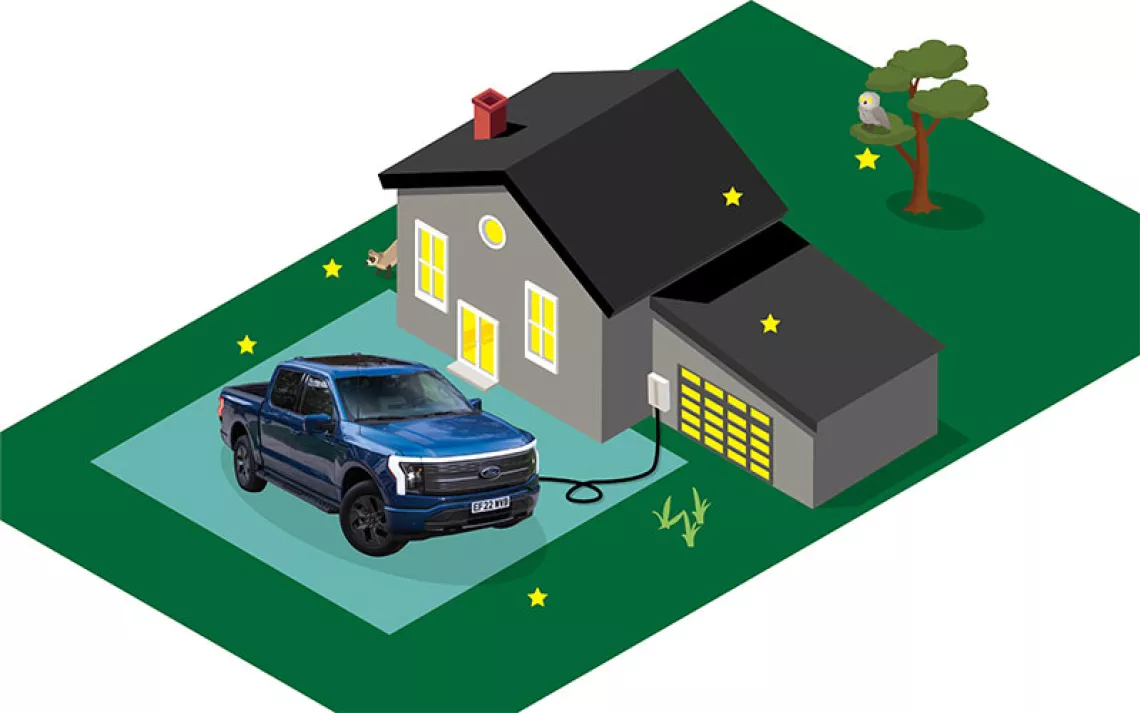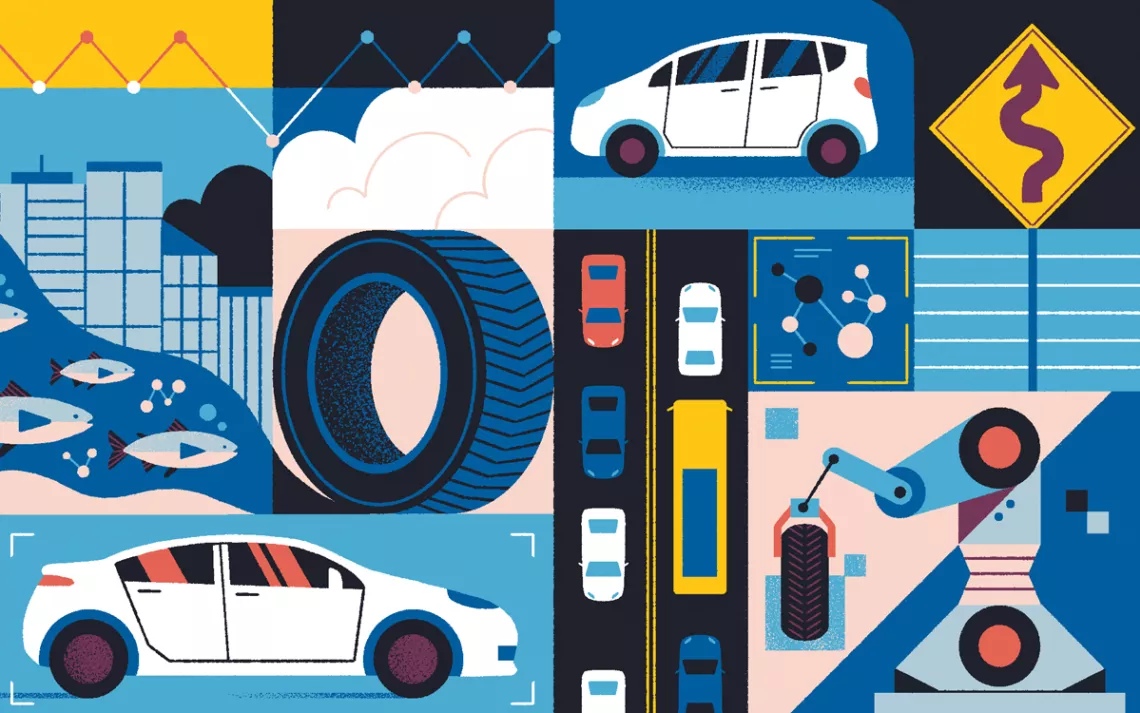Siri, Will Connected Vehicles Be Greener?
Smart cars promise to be greener, too, by reducing road congestion and lowering emissions

In the next few years, cars will not only talk to traffic lights but also to the electricity grid, to each other, and to buildings. Illustration by Cai Sepulis.
I'm riding in a Dodge Journey through downtown Washington, D.C., and the car is talking. "Right lane closed ahead," it says, followed by "Black ice—drive carefully."
The Dodge is picking up signals from transmitters on traffic lights, creating an experience similar to using Google's navigation app, Waze, which incorporates real-time information from drivers. This is only a pilot program, but some cities will soon be sharing with individual vehicles the voluminous traffic data they collect.
Welcome to the connected car. By 2020, according to the firm Allied Marketing Research, connected vehicles will grow into a $141 billion global business. In the next few years, cars will not only talk to traffic lights but also talk to the electricity grid (vehicle-to-grid, known as V2G), talk to each other (V2V), and talk to buildings (V2B).
The race to a new transportation future is well under way. "All automakers are competing on technology such as adaptive cruise control and lane keeping," says Wade Newton, a spokesman for the Auto Alliance, which represents 12 automakers. "It's not only about saving lives but improving fuel efficiency, too."
It sounds like a futurist's daydream, but our connected cars will be able to send signals to preheat homes, start dinner in the oven, and turn lights off and on. Smarter cars could be greener, too, as their intelligence helps to reduce congestion and lower emissions.
Networked cars don't necessarily have to be electric—and in fact, most of the self-piloted test cars on the road today run on gasoline. But climate change imperatives and rapid battery improvement are driving us in that direction. According to Bloomberg New Energy Finance, by 2040 more than one-third of all new cars worldwide will have a plug.
Electric vehicles have no tailpipe emissions and—even factoring in the emissions from the electricity used to charge them—are much cleaner than conventional cars. And they'll get even cleaner over time as we increase our use of renewable energy sources. Eventually, networked EVs will be able to dialogue with a parking garage and not only tuck themselves into a space but also connect to wireless charging. Try that in a gasoline-powered car.
Here's a look at what's coming down the pike.
Vehicle-to-Grid
At the University of Delaware, dozens of electric vehicles sit in a uniform row. They're part of an experiment involving BMW, power-generating company NRG, and PJM—a regional organization that moves electricity around 13 states and the District of Columbia—that's examining how EVs can give energy back to the electricity grid.
It works like this: When the cars are idle (our vehicles typically sit 95 percent of the time), they're plugged in and able to deliver the electricity in their batteries back to the grid. When energy demand is high, they return electricity to the grid; when demand is low, they absorb electricity. One car doesn't offer much, but 30 of them is another story—worth about 300 kilowatts of power. Utilities will pay for this service, called "load leveling," because it means that they don't have to turn on backup power plants, which are usually coal or natural gas burners. And the EV owners get regular checks—approximately $2.50 a day, or about $900 a year.
It's working well, according to Willett Kempton, a longtime V2G guru and University of Delaware professor who heads the school's Center for Carbon-Free Power Integration: "In three years hooked up to the grid, the revenue was better than we thought. The project, which is ongoing, shows that V2G is viable. We can earn money from cars that are driven regularly."
V2G still has some technical hurdles to overcome, but carmakers—and utilities, too—want it to happen. In a 2014 report, Edison Electric Institute, the power industry's main trade group, called on utilities to promote EVs, describing EV adoption as a "quadruple win" that would sustain electricity demand, improve customer relations, support environmental goals, and reduce utilities' operating costs.
Utilities appear to be listening. In Virginia and North Carolina, Dominion Resources is running a pilot project to identify ways to encourage EV drivers to only charge during off-peak demand. In California, San Diego Gas & Electric will be spending $45 million on a vehicle-to-grid integration system. At least 25 utilities in 14 states are offering customers some kind of EV incentive. And it's not just utilities—the Department of Defense is conducting V2G pilot programs at four military bases.
Paula DuPont-Kidd, a spokesperson for PJM, says V2G is especially useful for what's called "frequency regulation service"—keeping electricity transmissions at a steady 60 cycles per second. "V2G has proven its ability to be a resource to the grid when power is aggregated," she says. "We know it's possible. It just hasn't happened yet."
Vehicle-to-Vehicle
Eventually, the National Highway Traffic Safety Administration will require all new cars to be V2V enabled as a safety measure, but the technology has hit some roadblocks. Yes, Audi sent an autonomous car from San Francisco to Las Vegas last year, and Tesla's Elon Musk says his self-driving sedans will be hurtling across the United States by 2018. But as we speed down the road toward self-driving cars, it's important to realize that they won't get beyond the demonstration stage without a reliable way for cars to talk to each other, a reconfiguration of accident liability, and the resolution of myriad other details.
A major challenge is guaranteeing some bandwidth for V2V communication. The Federal Communications Commission has reserved the 5.9-gigahertz band for car-to-car chatter. But the cable giants are also covetous of the spectrum for wi-fi, and that could lead to interference. If V2V signals are delayed (as wi-fi is when a lot of people are using it), the result could be tragic—and avoidable—accidents.
But assuming that the communication-channel issue is figured out (as it likely will be, given the stakes involved), seamless V2V connectivity could prevent tens of thousands of lives lost in collisions. Officials with the safety administration believe that V2V could eventually prevent or reduce the severity of up to 80 percent of non-alcohol-related crashes.
There would be energy savings, too. Connected cars would make traffic patterns smoother and more predictable, relieving road congestion and reducing the amount of energy now wasted in traffic jams. Of course, that could just lead to more miles driven—unless connected cars also lead to an increase in ride-sharing. Many transportation industry insiders expect as much, and the big money is already going in that direction. Earlier this year, General Motors made a $500 million investment in the ride-sharing company Lyft and announced that it would develop an on-demand ride-sharing network piloted by self-driving cars.
Vehicle-to-Buildings
Turning your vehicle into a home energy source is not a totally new idea. Environmental engineering guru Amory Lovins has long touted the benefits of connecting cars to buildings. Some Toyota Prius owners have been able to keep their refrigerators humming during a blackout with Internet-sourced plans and a bit of home-electrical-system tinkering. Automakers are just beginning to realize the potential of V2B. In 2012, Nissan launched its Leaf to Home system in Japan. Consulting firm Navigant Research predicts that 200,000 V2B-equipped cars will be sold globally by 2020 (though that number may be optimistic).
For a century, cars have been dumb devices that only communicated with the road. Now that they are talking to everything in sight, our vehicles could be safer and more environmentally responsible than ever before. That's pretty smart.
This article was funded by the Sierra Club's Electric Vehicles Initiative. For more information, visit sierraclub.org/evguide.
 The Magazine of The Sierra Club
The Magazine of The Sierra Club



